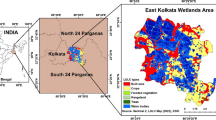Abstract
This contribution discusses the problemof providing measures of significance ofprediction results when the predictionswere generated from spatial databases forlandslide hazard mapping. The spatialdatabases usually contain map informationon lithologic units, land-cover units,topographic elevation and derived attributes(slope, aspect, etc.) and the distributionin space and in time of clearly identifiedmass movements. In prediction modelling wetransform the multi-layered databaseinto an aggregation of functional values toobtain an index of propensity of the landto failure. Assuming then that the informationin the database is sufficiently representativeof the typical conditions in which the massmovements originated in space and in time,the problem then, is to confirm the validity ofthe results of some models over otherones, or of particular experiments that seem touse more significant data. A core pointof measuring the significance of a prediction isthat it allows interpreting the results.Without a validation no interpretation is possible,no support of the method or of theinput information can be provided. In particularwith validation, the added value canbe assessed of a prediction either in a fixedtime interval, or in an open-ended time orwithin the confined space of a study area.Validation must be of guidance in datacollection and field practice for landslidehazard mapping.
Similar content being viewed by others
References
Carrara, A., Cardinali, M, Guzzetti, F., and Reichenbach, P.: 1995, GIS technology in mapping landslide hazard, In: A. Carrara and F. Guzzetti (eds.), Geographic Information Systems in Assessing Natural Hazards, Kluwer, Dordrecht, pp. 125–175.
Chung, C. F. and Fabbri, A. G.: 1993, The representation of geoscience information for data integration, Nonrenewable Resources, 2-2, 122–139.
Chung, C. F., Fabbri, A. G., Van Westen, C. J.: 1995, Multivariate regression analysis for landslide hazard zonation, In: A. Carrara and F. Guzzetti (eds), Geographic Information Systems in Assessing Natural Hazards, Kluwer, Dordrecht, pp. 107–133.
Chung, C. F. and Fabbri, A. G.: 1998, Three Bayesian prediction models for landslide hazard, In: A. Bucciantti (ed.), Proceedings of International Association for Mathematical Geology 1998 Annual Meeting (IAMG'98), Ischia, Italy, pp. 204–211.
Chung C. F. and Fabbri, A. G.: 1999, Probabilistic prediction models for landslide hazard mapping, Photogrammetric Engineering and Remote Sensing 65-12, 1389–1399.
Chung, C. F. and Fabbri, A. G.: 2001, Prediction model for landslide hazard using a Fuzzy set Approach, In: M. Marchetti and V. Rivas (eds), Geomorphology and Environmental Impact Assessment, Balkema, Rotterdam, pp. 31–47.
Chung, C. F. and Fabbri, A. G.: 2002, Modeling the conditional probability of the occurrence of future landslides in a study area characterized by spatial data, Proceedings of 2002 ISPRS (International Society for Photogrammetry and Remote Sensing) Meeting, Ottawa, Canada, July, 2002, in press.
Chung, C. F. and Jibson, R. W.: 2002, Quantitative prediction model for landslides hazard in the Northridge area, California, in preparation.
Chung, C. F. and Perret, D.: 2002, Landslide hazard mapping in La Baie, Quebec, Canada, in preparation.
Jibson, R. W., Harp, E. L., and Michael, J. A.: 1998, A method to produce probabilistic seismic landslide hazard maps. In: A. Bucciantti (ed.), Proceedings of International Association for Mathematical Geology 1998 Annual Meeting (IAMG'98), Ischia, Italy, pp. 211–217.
Leroi, E.: 1996, Landslide hazard - Risk maps at different scales: Objectives, tools and developments, In K. Senneset (ed.), Landslides. Balkema, Rotterdam, pp. 35–51.
Packard N. H. and Wolfram S.: 1985, Two-dimensional cellular automata, Journal of Statistical Physics 38, 901–946.
Panizza, M., Corsini, M., Soldati, M., and Tosatti, G.: 1998, Report on the use of new landslide susceptibility mapping techniques, In: J. Corominas, J. Moya, A. Ledesma, J. A. Gili, A. Loret, and J. Rius (eds), New Technologies for Landslide Hazard Assessment and Management in Europe (NEWTECH). Final Report, October 1998 of CEC Environment Programme Contract ENV-CT96-0248, UPC, Barcelona, pp. 13–31.
Terlien, M. T. J., Van Westen, C. J., and van Asch, T. W. J.: 1995, Deterministic modeling in GIS based landslide hazard assessment, In: A. Carrara and F. Guzzetti (eds), Geographic Information Systems in Assessing Natural Hazards, Kluwer, Dordrecht, pp. 57–78.
Van Westen, C. J.: 1993, GISSIZ: Training package for geographic information systems in slope instability zonation. Volume 1 - Theory, International Institute for Aerospace Survey and Earth Sciences (ITC) Publication N. 15, 245 pp.
Varnes D. J.: 1984, Landslides Hazard Zonation: A Review of Principles and Practice, UNESCO, Paris, Natural Hazards, Vol. 3, 63 pp.
Wang, S.-Q. and Unwin, D. J.: 1992. Modeling landslide distribution on loess soils in China: an investigation, International Journal of Geographic Information Systems 6-5, 391–405.
Zêzere, J. L.: 1996a, Landslides in the North of Lisbon region, In: A. B. Ferreira and G. T. Vieira (eds), Fifth European Intensive Course on Applied Geomorphology - Mediterranean and Urban Areas, Departamento de Geografia, Universidade de Lisboa, pp. 79–89.
Zêzere, J. L.: 1996b, Mass movements and geomorphological hazard assessment in the Trancao valley, between Bucelas and Tojal, In: A. B. Ferreira and G. T. Vieira (eds), Fifth European Intensive Course on Applied Geomorphology - Mediterranean and Urban Areas, Departamento de Geografia, Universidade de Lisboa, pp. 101–105.
Author information
Authors and Affiliations
Rights and permissions
About this article
Cite this article
Chung, CJ.F., Fabbri, A.G. Validation of Spatial Prediction Models for Landslide Hazard Mapping. Natural Hazards 30, 451–472 (2003). https://doi.org/10.1023/B:NHAZ.0000007172.62651.2b
Issue Date:
DOI: https://doi.org/10.1023/B:NHAZ.0000007172.62651.2b




